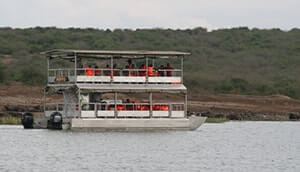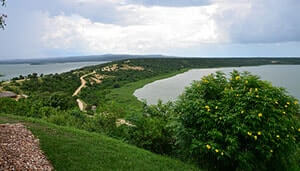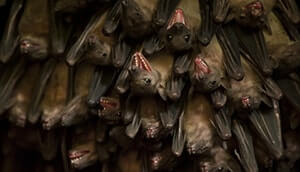Lake George is a lake in western Uganda and occupies an area of 250 square kilometres (97 square Miles). The lake with an estimated depth of just 2.4 meters is among Africa’s Great Lakes system even though itself is not considered a Great Lake. Similar to other regional lakes, this water body was named after a British royal family member, Prince George who later became King George V of the United Kingdom.
Lake George is close by Queen Elizabeth National Park, which spreads from it in the north east to Lake Edward in the south west with Kazinga Channel joining the two water bodies. A British explorer Henry M. Stanley is said to be the first European to have seen the lake in 1875, after ensuing the progression of the River Katonga right from Lake Victoria. Having thought it to be part of Lake Albert, Stanley called it Beatrice Gulf. And on his second exploration tour in 1888 through 1889, Stanley comprehended that the two were autonomous lakes and chose to name it Lake George, the name it holds to the present day.
Lake George is provided water by a number of inflows from the wide-ranging mountain Rwenzori ranges and from the northeastern agrarian zone. Nevertheless, the main entries are Mpanga and Dura from northeast plus Rumi, Nsonge and Mubuku. The northern shores of the lake are largely featured with a thick papyrus marsh and its water levels are inconsistent. The Lake usually gets two seasons of rain; with rainfall peaks in May and October and minimal amounts falling from 3 – 194 mm.
Lake George is exceptionally gainful in terms of enabling fishing. Its major islands are Iranqara, Kankuranga and Akika. The lake’s bordering swampland are a Ramsar Wetland zone that is a habitat to the sitatunga antelope and other animal species. Worth still, Shoebill specie is among the resident birds along the lake.
See More Safari Places in Queen Elizabeth National Park
 Kazinga Channel is a 32-kilometre long water channel that connects Lake George in the east to Lake Edward in the west. The channel is among the most paramount geographical features in Queen Elizabeth National Park with a magnificent view of the most vital wildlife in the park.
Kazinga Channel is a 32-kilometre long water channel that connects Lake George in the east to Lake Edward in the west. The channel is among the most paramount geographical features in Queen Elizabeth National Park with a magnificent view of the most vital wildlife in the park.
Kyambura Gorge – The Home Chimps  Kyambura Gorge is found in the far eastern side of Queen Elizabeth National Park in south western Uganda is roughly 1 km across and about 100 meters deeper. The gorge also known as the ‘Valley of Apes’ is drained by River Kyambura. Its a habitat to chimpanzees, other primate species and birds as well.
Kyambura Gorge is found in the far eastern side of Queen Elizabeth National Park in south western Uganda is roughly 1 km across and about 100 meters deeper. The gorge also known as the ‘Valley of Apes’ is drained by River Kyambura. Its a habitat to chimpanzees, other primate species and birds as well.
Ishasha Sector  The Isasha Sector found in the Southern part of Queen Elizabeth National Park is well-known for the amazing Tree-Climbing lions. Lions that hang in the big fig trees are an exceptional attraction and a key highlight of any Uganda safari tour this large national park. The Isasha lions relax in the tree branches as they also spy on their preys from above.
The Isasha Sector found in the Southern part of Queen Elizabeth National Park is well-known for the amazing Tree-Climbing lions. Lions that hang in the big fig trees are an exceptional attraction and a key highlight of any Uganda safari tour this large national park. The Isasha lions relax in the tree branches as they also spy on their preys from above.
Kasenyi Plains  Kasenyi Plains are part of Queen Elizabeth National Park. It is at these plains that the biggest percentage of game drive Uganda Safaris are carried out from. The plains are found on the western shores of the spectacular Lake George adjoining to the Kazinga Channel onto which the water makes a convergence.
Kasenyi Plains are part of Queen Elizabeth National Park. It is at these plains that the biggest percentage of game drive Uganda Safaris are carried out from. The plains are found on the western shores of the spectacular Lake George adjoining to the Kazinga Channel onto which the water makes a convergence.
Mweya Peninsula  Mweya Peninsula is found within Queen Elizabeth National Park on the northeastern shores of Lake Edward. The peninsula is the corner point where Kazinga Channel joins the lake. This beautiful piece of land surrounded by water either sides is approximately 66 kilometres by road from Kasese town.
Mweya Peninsula is found within Queen Elizabeth National Park on the northeastern shores of Lake Edward. The peninsula is the corner point where Kazinga Channel joins the lake. This beautiful piece of land surrounded by water either sides is approximately 66 kilometres by road from Kasese town.
Lake George  Lake George found in western Uganda covers 250 square kilometres. The lake with an estimated depth of 2.4 meters is part of Africa’s Great Lakes system. Though the lake itself is not considered a Great Lake. This water body was named after a British Prince, George who later became King George V.
Lake George found in western Uganda covers 250 square kilometres. The lake with an estimated depth of 2.4 meters is part of Africa’s Great Lakes system. Though the lake itself is not considered a Great Lake. This water body was named after a British Prince, George who later became King George V.
Lake Edward  Lake Edward, the tiniest of the African Great Rift Lakes is positioned on the border between Uganda and the Democratic Republic of Congo. The lake is just few miles south of the equator. The first European to see the lake was Henry Morton Stanley, a Welsh explorer who visited the lake in 1888 during the Relief Expedition of Emin Pasha.
Lake Edward, the tiniest of the African Great Rift Lakes is positioned on the border between Uganda and the Democratic Republic of Congo. The lake is just few miles south of the equator. The first European to see the lake was Henry Morton Stanley, a Welsh explorer who visited the lake in 1888 during the Relief Expedition of Emin Pasha.
Maramagambo Forest  Maramagambo Forest is found in Bushenyi district and is a part of Queen Elizabeth National Park. The forest is prominently associated with the Bat Cave and the Python. The forest is bounded by two crater lakes, Lake Nyamasingiri and Lake Kyasanduka and is a home to the red-tailed monkeys, chimps and Bates’ pygmy antelope (Neotragus batesi) among others.
Maramagambo Forest is found in Bushenyi district and is a part of Queen Elizabeth National Park. The forest is prominently associated with the Bat Cave and the Python. The forest is bounded by two crater lakes, Lake Nyamasingiri and Lake Kyasanduka and is a home to the red-tailed monkeys, chimps and Bates’ pygmy antelope (Neotragus batesi) among others.
